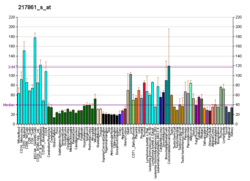| PREB |
|---|
|
| Identifiers |
|---|
| Aliases | PREB, SEC12, prolactin regulatory element binding |
|---|
| External IDs | OMIM: 606395; MGI: 1355326; HomoloGene: 40877; GeneCards: PREB; OMA:PREB - orthologs |
|---|
| Gene location (Human) |
|---|
 | | Chr. | Chromosome 2 (human)[1] |
|---|
| | Band | 2p23.3 | Start | 27,130,756 bp[1] |
|---|
| End | 27,134,666 bp[1] |
|---|
|
| Gene location (Mouse) |
|---|
 | | Chr. | Chromosome 5 (mouse)[2] |
|---|
| | Band | 5|5 B1 | Start | 30,950,853 bp[2] |
|---|
| End | 30,960,361 bp[2] |
|---|
|
| RNA expression pattern |
|---|
| Bgee | | Human | Mouse (ortholog) |
|---|
| Top expressed in | - right lobe of liver
- gastrocnemius muscle
- left uterine tube
- muscle of thigh
- body of pancreas
- apex of heart
- body of uterus
- right ovary
- granulocyte
- mucosa of transverse colon
|
| | Top expressed in | - fossa
- condyle
- Paneth cell
- granulocyte
- motor neuron
- seminal vesicula
- yolk sac
- internal carotid artery
- neural layer of retina
- endothelial cell of lymphatic vessel
|
| | More reference expression data |
|
|---|
| BioGPS |  | | More reference expression data |
|
|---|
|
| Gene ontology |
|---|
| Molecular function | - DNA binding
- guanyl-nucleotide exchange factor activity
- protein binding
- GTPase activator activity
- GTPase binding
| | Cellular component | - integral component of membrane
- endoplasmic reticulum membrane
- membrane
- endoplasmic reticulum
- endoplasmic reticulum exit site
- Golgi membrane
- nucleus
- integral component of endoplasmic reticulum membrane
| | Biological process | - protein transport
- IRE1-mediated unfolded protein response
- vesicle-mediated transport
- transcription, DNA-templated
- positive regulation of GTPase activity
- regulation of transcription, DNA-templated
- COPII vesicle coating
- protein exit from endoplasmic reticulum
- endoplasmic reticulum to Golgi vesicle-mediated transport
- regulation of COPII vesicle coating
- protein secretion
- transport
- regulation of molecular function
- regulation of catalytic activity
| | Sources:Amigo / QuickGO |
|
| Orthologs |
|---|
| Species | Human | Mouse |
|---|
| Entrez | | |
|---|
| Ensembl | | |
|---|
| UniProt | | |
|---|
| RefSeq (mRNA) | |
|---|
NM_001330484
NM_001330485
NM_001330486
NM_001330487
NM_013388 |
| |
|---|
| RefSeq (protein) | |
|---|
NP_001317413
NP_001317414
NP_001317415
NP_001317416
NP_037520 |
| |
|---|
| Location (UCSC) | Chr 2: 27.13 – 27.13 Mb | Chr 5: 30.95 – 30.96 Mb |
|---|
| PubMed search | [3] | [4] |
|---|
|
| Wikidata |
| View/Edit Human | View/Edit Mouse |
|















